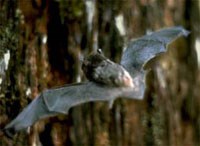|
Bats are often seen feeding on insects over water and in riparian zones in North Cascades National Park.
Bat Facts

Additional Resources: Visit the Species List page to explore the bat species in the park. |
Last updated: January 19, 2018
|
Bats are often seen feeding on insects over water and in riparian zones in North Cascades National Park.
Bat Facts

Additional Resources: Visit the Species List page to explore the bat species in the park. |
Last updated: January 19, 2018